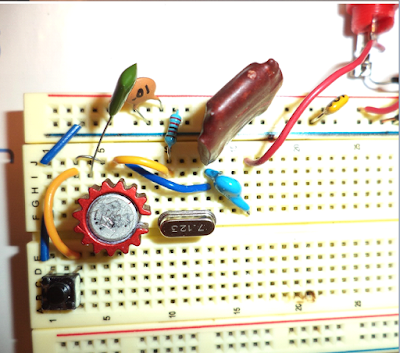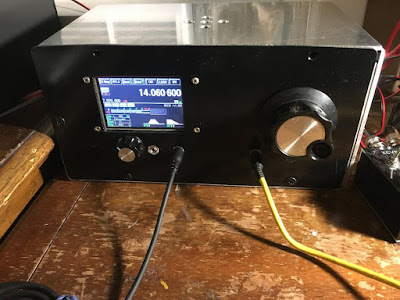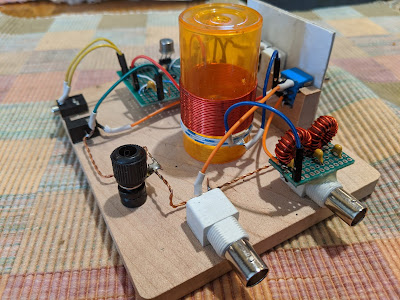Podcasting since 2005! Listen to Latest SolderSmoke
Friday, April 16, 2021
Homebrew Lives! TWENTY N6QW Simple SSB Transceivers Under Construction in Northern Virginia
Monday, March 22, 2021
My Hodgepodged Morse: Audio Tone into the Mic Jack Creates J2A not A1A. BASTA!
Don, ND6T
--------------------------------------------------
Hi Bill and Pete,
With putting an audio oscillator into you hodgepodge radio, your transmission is not the same as a standard CW rig.
If we have a transmitter as described in the ARRL handbooks from the 1940's or 1950's, (or even the Michigan Mighty Mite) it is a crystal oscillator and maybe a PA tube. By keying either the oscillator and/or the final PA on and off, then we can send Morse code as ICW Interrupted Continues Wave. If we check the list of emission designators, we have A1A.
However, if we feed a tone into a SSB transmitter, then we have J2A.
At the other end it may sound the same, but because it is created in a different way, it has a different designation.
A quick look at Part 97 shows that J2A and J2B are classed as CW, so you are in the clear. However, if you put a tone oscillator into an AM signal to send CW, then that would be classed as A2A and not classed as CW, but as MCW. MCW can be used on 6 meters and above, but not HF.
SITS.
73 de Peter VK2EMU
-----------------------------------------------------------
So I say BASTA with the J2A! If I want to go CW, it's all A1A for me. I dusted off my Fish Soup 10 and am now back on 40 CW with 200 mW.... A1A all the way!
Tuesday, July 21, 2020
A Quarantine Mighty Mite
Saturday, July 18, 2020
Overcoming the Complexity of the Michigan Mighty Mite: Walter's Sunrise Net Special
June 21, 2020
Michigan Mighty-Mite: Why So Complicated?
The April 2020 issue of QRP Quarterly magazine featured an article by Bob Rosier K4OCE which included a schematic for a “Ten Minute Transmitter” by G4RAW (SK), which apparently first appeared in SPRAT 82 in 1996.
It is even simpler than the Michigan Mighty Mite, so this transmitter can truly be built on a solderless breadboard in about 15 minutes, because a complex coil is not required.
The only tuning needed was for me to establish the correct value of the output series capacitor.
This rig allowed me to check-in to the Sunrise Net (see details in blue text on my QRZ page) today on my very first attempt, and landed me a 549 signal report from 250 miles away.
The first photo shows the transmitter connected to a Transmit/Receive Switch mounted in an Altoids box. In the Transmit position the antenna is disconnected from my 1979 Heathkit HR-1680 receiver, which then coincidentally supplies a sidetone at an ideal volume level. That little black pushbutton which can be seen in the second photo serves as my key, and works just fine for a five-minute daily QNI on the Sunrise Net.
Of course, part of the secret is having a crystal exactly on the Net frequency, and I have a few left, free to whomever in the Eastern U.S. is interested in building one of these simple Sunrise Net Special Transmitters and participating in our Net.
Monday, June 1, 2020
Adam N0ZIB's FB Station (and UGLY Michigan Mighty Mite)
Bill and Pete,
Monday, April 20, 2020
Dean KK4DAS Builds SSB rig, Makes First Contact.
Thursday, April 9, 2020
WB9IWT's Quarantine Mighty Mite and N3FJZ's "Hiram Percy Maxim Recognition Factor"
Leif WB9IWT has, during the emergency, been working on a Michigan Mighty Mite (See pictures above and below). FB Leif.
But also check out the very astute comment from Rick N3FJZ (below) . I am, of course, all in favor of the HPMR Factor. Almost all of my rigs would score quite high. Others, I know, would seek a low score. To each his own. This is all for fun.
Leif,
Great work. If a ham from the 1920's were to see this rig, they
probably wouldn't recognize the actual components right away (but
knowing hams, they would no doubt figure it out), but the breadboard
layout circuit flow would be immediately recognizable; e.g. the plug-in
crystal, the coil, binding post. The transistor and variable capacitor
may baffle them at first, but seeing there are three leads on the
transistor would start to give them clues.
That's the cool part about analog discrete component radio, no matter
how many years go by, and the appearance and size of the actual
components change, the physics of what's going on at the electron level
stays the same (SDR not withstanding).
I guess this could be a litmus test for us analog radio builders. It
could be called the "Hiram Percy Maxim Recognition Factor" or "HPMR
Factor" with a range of 0 to 1. After you build your rig, take a look
at it and pretend that you could present it to Mr. Maxim and the more he
could understand the circuits, components and circuit flow on his own,
the closer to a factor of 1 your radio would achieve. For example, an
SDR might only achieve a factor of .1 or even maybe 0, where as your rig
may achieve a factor of .8, and one of your crystal receivers would
definitely get a 1.
Someone could even workout a check list or formula where you would add
or subtract some fractional numeric values for each component you used;
e.g. you would subtract some value for every IC chip, microprocessor or
LCD display you use, and add some fractional value for each hand wound
coil, vacuum tube/valve or open air variable capacitor, et cetera.
Fun to think about.
Keep building.
Rick - N3FJZ
Wednesday, March 25, 2020
For Inspiration and Education: Dean's Radio Blog (with video)
Be sure to check out the blog of Dean KK4DAS. He is a new homebrewer who is having great success with one of Pete Juliano's ingenious SSB designs. Dean has a video of his receiver working -- AL FRESCO -- as construction on the full transceiver proceeds.
This is amazing. Just a short time ago Dean was taking his first steps as a homebrewer with his version of the Michigan Mighty Mite. He has followed the advice of the Tribal Wizards and has proceeded slowly, step by step, stage by stage, gaining the experience that has allowed him to actually build a superhet receiver and be on the verge of completing a full SSB transceiver.
Lots of inspiration to be found on Dean's blog. Check it out:
https://kk4das.blogspot.com/2020/03/dean-kk4dass-furlough-40-ssb-rig.html
Saturday, February 1, 2020
SolderSmoke Podcast #217 -- Beach trip, '30s station, uBITX mods, HRO RX AM, ELMAC, Teensy, MAILBAG
 |
| Bill's Bavaro DR Beach Station uBITX in the box, HB key |
 |
| Pete's Plank SDR When you know stuff, you can do stuff! |
Sunday, December 29, 2019
KK4DAS Michigan Mighty Mite Heard by WEB SDRs -- CBLA Mobilized!
Sunday, December 22, 2019
Dean KK4DAS Puts Michigan Mighty Mite on the air! And is heard in Falls Church, Virginia! (video)
QRZ.com says we are 5.9 miles away. The U.S. Postal Service almost prevented this from happening -- they objected to my just putting the crystal in an envelope and mailing it. Dean's wife had to pay postage due.
The rig didn't work at first, but Pete N6QW provided sage advice and tribal knowledge. Adjustments were made and Dean experienced the Joy of Oscillation. Then, he connected an antenna and was heard at the SolderSmoke East Coast HQ.
Obviously the beret was the key to Dean's success:
Thursday, August 24, 2017
The Return of Pete's Simple-ceiver Plus (and a possible analog option)
Winter is approaching ladies and gentlemen, and it is time to think about radio projects. Bob N7SUR suggested a direct conversion receiver project. I think this is a great idea. As a kid, I had fallen victim to the idea that building receivers was "too hard" for radio amateurs. Not true! DC receivers to the rescue! Carry on with the DC revolution first launched by Wes W7ZOI in 1968.
Pete N6QW is providing guidance and tribal knowledge via his blog. For those of you who want to join the ranks of those who have defied the conventional wisdom and have broken through the "receivers are too hard" barrier. I say build yourself a DC receiver. Build it from scratch. Many of you already got your feet wet in homebrewing with the Michigan Mighty Mite project. Now it is time to jump into a DC receiver project.
You folks already know what kind of VFO Pete will prefer: It will be an Si5351. That's fine. But I will try to keep the banner of discrete component analog ludite-ism flying high. This morning I ordered a batch of 7.37 MHz ceramic resonators. I hope to pull them down into a significant portion of the 40 meter phone band. If this works, I will share the batch with anyone who wants to joining my Analog Army (remember the CBLA?). Note (above) that Pete has magnanimously left open the possibility of using a non-digital VFO. What a guy!
Check out Pete's project here:
http://n6qw.blogspot.com/2017/08/a-new-line-of-transceivers-difx_19.html
Wednesday, March 8, 2017
WU2D's Wonderful Video on Retro-QRP
(Link to video appears below.)
Stephen G7VFY sent me the link to Mike WU2D's Retro-QRP video. In the last month spoken to Mike at least twice on 40 and 75 meter AM. Stephen was responding to a post I did about a 1958 18 milliwatt solid state QRP rig.
Mike's video is really wonderful. I've never been into military surplus, but this video made me think I might want an ARC-5. The rig Mike builds and tests is very similar to our beloved Michigan Mighty Mite. His description of the build and the testing procedures he used will be of great interest to those who've built the MMM rigs. And he made some contacts. Finally, there is a cameo appearance by Paris Hilton. And she is holding a HOT transistor! Wow!
Mike has a real talent for making these kinds of videos. Thanks a lot Mike -- see you on 40. And thanks Stephen (Stephen has sent us so much great stuff over the years, including a fantastic box of British valves.) Pete: See how nice it is to get back to QRP?
Here's Mike's YouTube Channel. I love the intro:
https://www.youtube.com/channel/UCN7RQv_qmzhzuJV1HhJ4OEA
Saturday, August 13, 2016
KB8M's Mighty Mite -- Beware the Treacherous P2N2222!
Sunday, July 17, 2016
HB2HB QSO with N6ORS -- MIN-X to BITX
http://soldersmoke.blogspot.com/2016/01/n6orss-min-x-crosses-pond-on-first.html
I was on twenty today with my BITX, finishing up a rather disheartening contact with a fellow who told me that he is a "checkbook operator." I was trying to encourage this fellow to build something simple -- perhaps a Michigan Mighty Mite? He told me that he might give it a try, but only 16 years from now, after he retires. It was like a case of the Anti-Knack! Then Keith N6ORS saved the day by calling in with his beautiful MIN-X HOMEBREW transceiver. We had a nice talk -- Keith mentioned the beauty of Pete's "Blue Rig." That's HB2HB (phone) QSO #5 for me. Thanks Keith!
Bill,
That was great fun!
I was just tuning around and heard you mentioned the Michigan Mighty Mite
so I stopped to listen and realized it was you!
Well here was my chance for a homebrew to homebrew with 'the man' himself.
I wanted to record it but missed the chance.
Here is the Min-x boxed up. the case is made from thrown away computer cases.
It runs about 70watts on 160,80 and 40 meters and about 35watts on 20 meters.
I promise to write it up, maybe even draw a schematic. hihi.
73,
Keith N6ORS
Here' a short clip of the MINX in action:
Wednesday, May 25, 2016
Swedish Michigan Mighty Mite Beacon Project
sTef DL1FDF/VY1QRP alerted us to this multi-band Michigan Mighty Mite beacon project out of Sweden. They certainly have some fine looking rigs!
Check out the reports:
http://www.radiorud.se/fyren.php
Wednesday, April 20, 2016
Meeting up with ARRL CEO Tom Gallagher, NY2RF
Tuesday, April 5, 2016
My Mate for the Mighty Midget Thermatron Receiver


Wednesday, March 16, 2016
VA2NM's Michigan Mighty Mite (with Tuna Tin LPF!) (video)
Here is my contribution... After managing to somehow get my hand wound transformer to melt a pill container, I used my Dad's hand made, circa 1950 transformer and got it working on a 1.4 MHz xtal and also on 3.58 MHz with a colour burst xtal. A re wound coil on the remaining unmelted pill container worked on 40 meters. I succeeded in getting my Mighty Mite working on three bands. My father would have been pleased, as this was kept aside all this time and now has been put to use. He had built the coil while working part time in post World War II England at the GEC labs in U.K.
Thanks for the motivation! I'm going to move forward and clean up the 80 meter signal and see how far it goes on the reverse beacon website.
The coil form was about 80 turns on a 1 inch diameter with a 20 turn secondary that I used for the center tap portion by joining both bottom ends. Then I wound an 10 trim secondary, loaded up with a 50 ohm resistor to tune up (capacitor fully opened up) on 3.58 MHz in the video, and the audio coming from my receiver tuned to the 3.58 MHz signal.
Nigel Maund
Saturday, March 12, 2016
EMRFD Joy of Oscillation (Part 1)
Guys:
I have been catching up on the last few SolderSmoke podcasts after
that little QSO Today diversion. I wonder how many others did the
same thing? I have really enjoyed these recent 'casts. Lots of
fantastic HB content. Funniest moment was when Bill described his
post-project workshop as looking like the aftermath from an electronic
barfight.
I took a new ham up on a SOTA activation last year. Then about a
month ago, he said that he wanted to do HF HB. He said he had been
googling and found so much that he didn't know where to start. I told
him that I'd be interesting in doing a beginner HF HB project with
him.
I could have pointed him to LBS, et al. I could have pointed him to
the Michigan Mighty Mite. I did neither. I pointed him to:http://web.cecs.pdx.edu/~
the document. I pointed him also to:http://www.arrl.org/files/
(Did you guys know that chapter was online and free?) We scaled to 20m and
kitted parts for this. And parts for a 4th transistor PA for serious
QRO. :-)
Two others joined us building for 40m. Check out the attached photos
of the first 3. The joy of oscillation was experienced by all.
After testing each oscillator, and borrowing from an article KK7B ran
in CQ VHF, I told each that he had to ID every 10 minutes. Even
though nobody was going to hear these signals a few hundred yards
away. (But it sounds loud on a shortwave portable a few inches away!)
I even wrote out the dots and dashes for a couple of them.
Next stop: to have everyone find a curbside TV discard, rip out some
parts, and get on 5 meters! Haven't we gotten it back now, after the
transition to digital TV? :-)
OK, maybe the next stop is to add some gain stages and experience the
joy of communication. The joy of QSO-ification? The joy of
EM-radiation? :-)
Best regards,
Drew
kb9fko














































